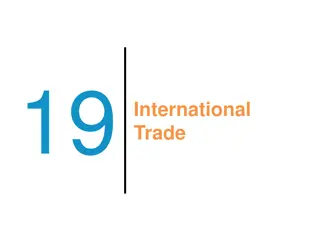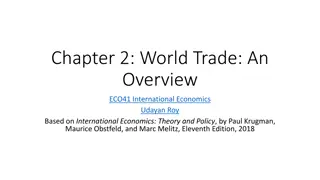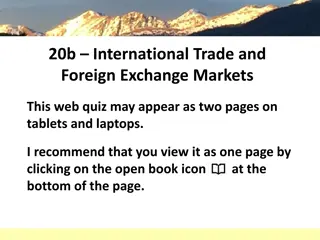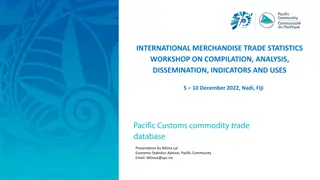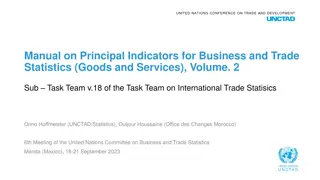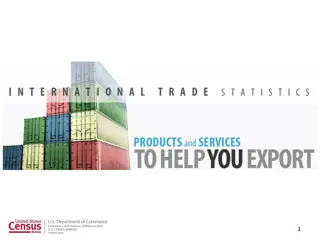Understanding Transportation Documents in International Trade
International trade relies on various documents to facilitate transactions, including transportation documents, invoices, and insurance policies. These documents are crucial for commercial operations and compliance with exchange control regulations in different countries. Main transportation documents include bills of lading, airway bills, and courier receipts, each serving as contracts for the carriage of goods and receipts at the destination. Among these documents, the Bill of Lading is a key legal instrument that acknowledges receipt of goods by the carrier in shipping transactions.
- Transportation documents
- International trade
- Bill of Lading
- Commercial operations
- Exchange control regulations
Download Presentation

Please find below an Image/Link to download the presentation.
The content on the website is provided AS IS for your information and personal use only. It may not be sold, licensed, or shared on other websites without obtaining consent from the author. Download presentation by click this link. If you encounter any issues during the download, it is possible that the publisher has removed the file from their server.
E N D
Presentation Transcript
TRANSPORTATION DOCUMENTS
GENERAL INFO We all know, International trade necessitates for evidence about trade in the form of different documents.
The need for these documents arise out of commercial factors, exchange control regulations in certain countries require certain documents.
IMPORTANT DOCUMENTS ARE; 1. Bill of exchange. 2. Transport documents. 3. Marine insurance policy. 4. Invoices. 5. Other documents.
TRANSPORTATION DOCUMENTS Transport documents lies in the heart of international trade transactions. These documents are issued by shipping line, airline, international trucking company, rail road, freight forwarders and logistic companies.
There is a type of document for each mode of transport All transport documents have in common three elements: They are contracts for the carriage of the goods. They serve as receipt of the goods at the state destination. They have a similar structure in terms of number of boxes, content and language used.
MAIN TRANSPORT DOCUMENTS 1. Bill of lading. 2. Multimodal bill of lading. 3. Airway bill. 4. Road, rail or inland waterway transport documents. 5. Courier receipts. 6. CMR documents. 7. Cargo insurance certificate. 8. Packaging list. 9. Delivery note.
BILL OF LADING: Sometimes misspelled as "Bill of Landing," the Bill of Lading (BOL) is a legal document between the shipping carrier and your business stating that your shipping carrier has received the goods you're shipping with them.
WHAT IS A BILL OF LADING? A Bill of Lading, in its simplest form, is a receipt. The document states that the carrier has received the shipment and contains information about the shipper and the receiver. There are several alternate names and abbreviations for the term "Bill of Lading:" -Bill of Landing (Common misspelling.) -BOL -B/L
FEATURES Nature of Bill of Lading; a) Receipt of goods received by carrier b) Evidence of contract of carriage c) Document to title of goods
CONTENTS OF BILL OF LADING: The general nature of goods. Leading marks for identification of the consignment. The number of packages or pieces. The weights of the goods or their quantity otherwise expressed.
The apparent condition of the goods, normally BOL declares that the goods have been received in apparent goods order and conditions; The name and principal place of business of shipping company The name of shipper (consigner) The consignee. Notify address. The port of loading. The number of originals of bill of lading issued. The place of issuance of bill of lading. The signature of the master of the ship or an agent of the shipping company. The freight to the extent payable by the consignee or other indication that the freight is payable by him or particulars of freight paid.
TYPES OF BILL OF LADING: Through or port to port bill of lading: Where goods are to be carried by two or more ships or partly by ship and partly by train, the bill of lading providing for continuous responsibility of all the shipping companies or the shipping company or railway company is called a through bill of lading .
Stale bill of exchange: Occasionally in cases of short-overseas cargo transportation, the cargo arrives to port before the Bill of Lading. When that happens, the Bill of Lading is then "stale."
Charter party bill of lading: A complete ship may be made available to a shipper for a particular voyage or for a particular period of time. These document containing the terms and conditions of this contract is known as the charter party bill of lading.
House bill of lading: A few freight forwarders indulge in collection of cargo from different shippers and arrange for a consolidated shipment under their name, normally in containers. They issue their own bill of lading in favor of the shippers who have entrusted them with shipment. Such bill of of lading is called house bill of lading .
Liner bill of lading: A liner vessel is a ship operating on a fixed route between two ports or series of ports. It operates a regular scheduled service and the freight charges can be quoted from a fixed schedule. Its an arrangement between liners operating on same route to avoid unhealthy competition among themselves.
Short form bill of lading: A bill of lading, which indicates some or all of the conditions of carriage by reference to a source or document other than bill of lading itself, is called a short form or blank back bill of lading.
Third party bill of lading: It is a bill of lading in which the consigner is a party other than the seller. This BOL is acceptable because Article 14(k) states that shipper or consignor of the goods indicated on any document need not to be beneficiary of the credit.
Multimodal Bill of Lading : -A Multimodal Bill of Lading FBL is an international transport document covering two or more modes of transport, such as shipping by road and by sea. -It is also used as a carriage contract and receipt that the goods have been received. -It can be negotiable or non-negotiable.
Airway bill: -An Air Waybill AWB is a nonnegotiable transport document covering transport of cargo from airport to airport. -Carriage by air is suitable where quick delivery is essential. It is frequently employed in carriage of life saving drugs, costly and sophisticated items etc where the parties require the goods to be carried expeditiously.
NATURE AND CONTENT OF AIRWAY BILL: oPlace and date of execution. oPlace of departure and destination. oAgreed stopping places. oName and address of consignee oNature of goods oValue of goods oNumber of packages and identification marks oWeight, quantity and volume/ dimensions of goods. oApparent conditions of goods and packaging oFreight, paid or yet to collect.
ROAD, RAIL OR INLAND WATERWAY TRANSPORT DOCUMENTS: Indicate the name of the carrier and: be signed by the carrier or a named agent for or on behalf of the carrier, or indicate receipt of the goods by signature, stamp or notation by the carrier or a named agent for or on behalf of the carrier. indicate the date of shipment or the date the goods have been received for shipment, dispatch or carriage at the place stated in the credit. Unless the transport document contains a dated reception stamp, an indication of the date of receipt or a date of shipment, the date of issuance of the transport document will be deemed to be the date of shipment.
COURIER RECEIPTS: A courier receipt, evidencing receipt of goods for transport, must appear to indicate the name of the courier service and be stamped by the named courier service at the place from which the credit states goods are shipped.
CMR DOCUMENT: The CMR transport document is an international consignment note used by drivers, operators and forwarders alike that governs the responsibilities and liabilities of the parties to a contract for the carriage of goods by road internationally. The carrier usually completes the form, but the sender -in other words the exporter-is responsible for the accuracy of the information and must sign the form when on delivery, which is essential for the carrier to be able to confirm the delivery of The CMR transport document is not a document of title and is therefore nonnegotiable. This document is prepared by the exporter and the freight forwarder and is addressed to the importer and the carrier.
CARGO INSURANCE CERTIFICATE: The Cargo Insurance Certificate is a document indicating the type and amount of insurance coverage in force on a particular shipment. It includes the name of the insurance company and conditions of coverage.
In addition to these documents prepared and managed transportation companies, it should also mention three other documents prepared by the exporter which accompany the goods during transportation: international commercial invoice, packing list and delivery note.
INTERNATIONAL COMMERCIAL INVOICE: The International Commercial Invoice is an administrative document which contains all the information about the international sale. The item, quantity, price for the products/services sold, delivery and payment conditions, as well as the taxes and other expenses that might be included in the sale, are detailed in an International Commercial Invoice.
PACKING LIST: The Packing List is a more detailed version of the commercial invoice but without price information. It contains invoice number, quantity and description of the goods, weight of the goods, number of packages, and shipping marks and numbers.
Although not required in all transactions, it is required by some countries and some buyers. This document is prepared by the exporter and addressed to the importer, the carrier and the import customs clearance.
DELIVERY NOTE: Delivery Note is a document accompanying the shipment of goods that list de description and quantity of goods delivered. A copy of the Delivery Note, signed by the buyer or consignee is returned to the seller or consignor as a proof of delivery.
Delivery Notes have a dual function for the exporter: justify the removal of the products from its store and proof credit delivery to the importer and therefore it is important that de importer sign the copy provided by the carrier. For the importer, Delivery Notes serve to verify that the goods received match those listed on the purchase order or contract. For the carrier is the document used as a delivery note.
CONCLUSIONS: Transport documentation is needed to provide instructions to the carrier on what should be done with the goods. They can be used to pass responsibility for, and sometimes ownership of, the goods during their journey.
The carrier should provide you with documentary evidence that they have received the goods, eg: a bill of lading or a waybill. You should keep any documents as evidence in case of later problems with the shipment. You may need to insure the goods, and you may also be required to provide proof of insurance to your customer, particularly if you are passing on the costs.









